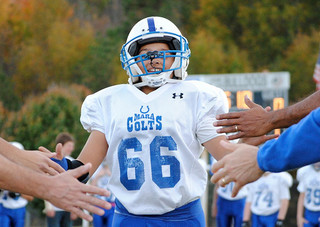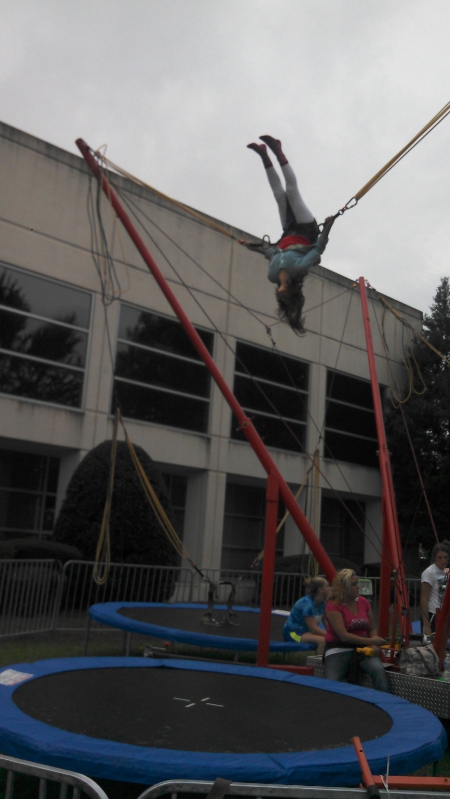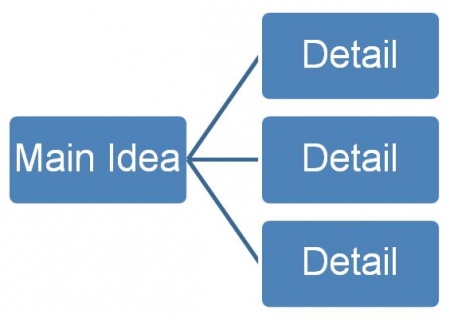Main Idea, Theme, and Details Content Module
BACK TO Content Modules
Contents |
Plot the Course
The rationale
Whether reading a story, a content area text book, a comic, or a poem, the ability to determine the main idea, theme, and supporting details is a lifelong skill readers use to foster higher level thinking and deeper comprehension.
Module Goal
The goal of this module is to provide detailed information on determining the main idea and theme using supporting details of a text to teachers of students with disabilities at the elementary and middle school level. This module aims to provide teachers with a general overview of these concepts as well as teaching suggestions so that a teacher can begin to plan instruction for these concepts. Additionally, this module provides instructors with potential adaptations and modifications to consider when designing materials and instruction for students with severe disabilities.
Module Objectives
After viewing the content module, teachers will:
- Develop a deeper understanding of determining main idea, theme, and supporting details as proficient reader strategies.
- Learn instructional strategies for teaching students how to determine main idea and theme and find supporting details when reading to enhance comprehension.
This module is organized using the following sections: Time for Take Off, Floating on Air, and Prepare for Landing. Key vocabulary is provided in the "Time for Take Off" section of the module. Connections to the Common Core State Standards and PowerPoint presentations containing information and instructional suggestions for teaching about main idea, theme, and details are shared in the "Floating on Air" component. In "Prepare for Landing", strategies to review, reinforce, and apply main idea and theme to real world connections are provided.
Time for Take Off
Understanding the vocabulary used when learning about main idea, theme, and details is important for both teachers and students in planning and implementing reading lessons. As a teacher, knowing and using the terms not only ensures your instruction stays true to the content, but will also help with collaborating with other reading teachers or literacy experts. When choosing which vocabulary to teach, it is most important that the teacher selects the most salient, important, or most frequently used vocabulary for each lesson.
Below you will find a list of vocabulary related to this module. It may or may not be necessary to provide instruction for all terms as students may have learned them previously. If you are a secondary teacher and are not confident your students have been taught these vocabulary terms, you may want to review and teach those unknown terms during the focus and review section of your lesson plan. While providing vocabulary instruction, you may consider including pictures or objects to make the instruction more concrete for students with disabilities (See Ideas to support vocabulary learning below).
Vocabulary
- summary - containing the key points or big idea
- main idea - the most important idea in the text
- details - specific smaller elements that are part of a larger work
- key word - essential or significant words related to the text
- relevant - has significant importance
- irrelevant - not important or related
- characters - person/persons in a story
- setting - place where the story happens
- plot - sequence of events involving characters in conflict situations
- point of view - perspective from which the story is told
- theme - moral or big idea of the story
- inference - a conclusion or opinion that is formed based on facts or evidence
- context clues - words and sentences within a text that provide additional information
Idea to support vocabulary learning
Use visual representations or actions to explain main idea, theme, and supporting details and their terms. For example, the following images may be shared to teach some common 'themes'.
Floating on Air
Before you can begin teaching your students about main idea, theme, and supporting details, it is important that you first have a deep understanding of the information. Some of the concepts may be familiar to you. Below is a list containing Standard R.L.2, R.I.2, R.L.9, and R.I.9 from the Common Core State Standards for grades K-8. You will also find a series of PowerPoint presentations containing information, examples, and instructional suggestions for teaching main idea, theme, and supporting details below the chart.
ELA Common Core State Standard 2 and 9: Main Idea, Theme, and Details - Grades K-8
| K | RL.K.2.With prompting and support, retell familiar stories, including key details.
RI.K.2. With prompting and support, identify the main topic and retell key details of a text. RL.K.9. With prompting and support, compare and contrast the adventures and experiences of characters in familiar stories. RI.K.9. With prompting and support, identify basic similarities in and differences between two texts on the same topic (e.g., in illustrations, descriptions, or procedures). |
| 1 | RL.1.2. Retell stories, including key details, and demonstrate understanding of their central message or lesson.
RI.1.2. Identify the main topic and retell key details of a text. RL.1.9. With prompting and support, compare and contrast the adventures and experiences of characters in familiar stories. RI.1.9. Identify basic similarities in and differences between two texts on the same topic (e.g., in illustrations, descriptions, or procedures). |
| 2 | RL.2.2. Recount stories, including fables and folktales from diverse cultures, and determine their central message, lesson, or moral.
RI.2.2. Identify the main topic of a multiparagraph text as well as the focus of specific paragraphs within the text. RL.2.9. Compare and contrast two or more versions of the same story (e.g., Cinderella stories) by different authors or from different cultures. RI.2.9. Compare and contrast the most important points presented by two texts on the same topic. |
| 3 | RL.3.2. Recount stories, including fables, folktales, and myths from diverse cultures; determine the central message, lesson, or moral and explain how it is conveyed through key details in the text.
RI.3.2. Determine the main idea of a text; recount the key details and explain how they support the main idea. RL.3.9. Compare and contrast the themes, settings, and plots of stories written by the same author about the same or similar characters (e.g., in books from a series). RI.3.9. Compare and contrast the most important points and key details presented in two texts on the same topic. |
| 4 | RL.4.2. Determine a theme of a story, drama, or poem from details in the text; summarize the text.
RI.4.2. Determine the main idea of a text and explain how it is supported by key details; summarize the text. RL.4.9. Compare and contrast the treatment of similar themes and topics (e.g., opposition of good and evil) and patterns of events (e.g., the quest) in stories, myths, and traditional literature from different cultures. RI.4.9. Integrate information from two texts on the same topic in order to write or speak about the subject knowledgeably. |
| 5 | RL.5.2. Determine a theme of a story, drama, or poem from details in the text, including how characters in a story or drama respond to challenges or how the speaker in a poem reflects upon a topic; summarize the text.
RI.5.2. Determine two or more main ideas of a text and explain how they are supported by key details; summarize the text. RL.5.9. Compare and contrast stories in the same genre (e.g., mysteries and adventure stories) on their approaches to similar themes and topics. RI.5.9. Integrate information from several texts on the same topic in order to write or speak about the subject knowledgeably. |
| 6 | RL.6.2. Determine a theme or central idea of a text and how it is conveyed through particular details; provide a summary of the text distinct from personal opinions or judgments.
RI.6.2. Determine a central idea of a text and how it is conveyed through particular details; provide a summary of the text distinct from personal opinions or judgments. RL.6.9. Compare and contrast texts in different forms or genres (e.g., stories and poems; historical novels and fantasy stories) in terms of their approaches to similar themes and topics. RI.6.9. Compare and contrast one author's presentation of events with that of another (e.g., a memoir written by and a biography on the same person). |
| 7 | RL.7.2. Determine a theme or central idea of a text and analyze its development over the course of the text; provide an objective summary of the text.
RI.7.2. Determine two or more central ideas in a text and analyze their development over the course of the text; provide an objective summary of the text. RL.7.9. Compare and contrast a fictional portrayal of a time, place, or character and a historical account of the same period as a means of understanding how authors of fiction use or alter history. RI.7.9. Analyze how two or more authors writing about the same topic shape their presentations of key information by emphasizing different evidence or advancing different interpretations of facts. |
| 8 | RL.8.2. Determine a theme or central idea of a text and analyze its development over the course of the text, including its relationship to the characters, setting, and plot; provide an objective summary of the text.
RI.8.2. Determine a central idea of a text and analyze its development over the course of the text, including its relationship to supporting ideas; provide an objective summary of the text. RL.8.9. Analyze how a modern work of fiction draws on themes, patterns of events, or character types from myths, traditional stories, or religious works such as the Bible, including describing how the material is rendered new. RI.8.9. Analyze a case in which two or more texts provide conflicting information on the same topic and identify where the texts disagree on matters of fact or interpretation. |
Deepen your understanding
Click on each PowerPoint below.
Great! Now that you have viewed the PowerPoint presentations, the next section will provide some ideas to consider when planning for Universal Design for Learning.
Sharing the Sky
UNIVERSAL DESIGN FOR LEARNING
| Visual Impairment or Deaf/Blind | Physical Impairment:
Little/ No Hand Use |
Lacks Basic Concepts | Motivational/ Attention Issues | |
| Representation | Use a talking device such as an avatar; use large print text, raised text or Braille, use objects and images to represent the main idea or theme; use online tools to create graphic organizers (i.e., Readwritethink.org); Use picture cards and graphic organizers to sort key aspects of the text including key words (i.e., character, setting, etc.). | Student scans an array of possible options and uses a switch to select the correct answer when asked a question pertaining to a given text; use computer representation of key aspects of the text that can be manipulated with switch; place key aspects of the text on a slant board or eye gaze board; create an exercise in the classroom that the student can walk or ride in wheelchair to find the main idea or theme in the text. | Use appropriate and accessible text. Rewrite text to simplify plot and details. Include additional images and illustrations to help convey the meaning of the text. Provide students with graphic organizers and sentence starters. Highlight key words within the context of the print. | Use motivating objects and topics to determine the main idea, theme, and details (i.e., puppets or student's favorite character, animal, etc.). Incorporate technology including computer representations, videos, animations, and talking avatar. Allow students to self-select text of interest. |
| Expression | Student states answer; use voice output devices for student to select the correct answer; teach tangible symbols for key phrases (i.e., characters' feelings/actions, setting, problem, theme, etc.) | Uses a switch to indicate correct answers; uses an eye gaze board to select answer; uses a blink response to select answer; phrase questions so that they require a "yes/no" response, these can easily be answered using an eye gaze, head turn, two switches, etc. | Student selects pre-made cards with key ideas from the text versus writing them; selection of correct answer is done after a model; student answers "yes/no" questions. | Have students find the main idea, theme, and details with images, drawing, interactive computer programs, etc. |
| Engagement | Teach students to use their hands to scan objects; use talking avatars or read aloud of text; start with simple, large print text and online interactive text; use text featuring topics and characters that are familiar and reinforcing to students. | Use bright colors to call attention to key words; use a computer with AT where the student can click to answer; use cards that are large enough to accommodate the movements that the student is able to make; pair student with another student without a physical impairment and have them work together to find the main idea, theme, and supporting details of the text. | Student uses websites and listening centers that read aloud text. Use bright colored stickers or sticky notes to mark key words within text. Use puppets, objects, and picture cards to find the main idea, theme and supporting details in the text. Explicitly model using think alouds along with visual images and actions. | Create games in which students interact with partners to find the main idea, theme, and details using cards with images. Create stories and text that involve the students and their personal interests and experiences. |
Concept Map
Prepare for Landing
Below you will find ideas for linking main idea, theme, and supporting details to real-world applications, the college and career readiness skills addressed by teaching these concepts, module assessments for teachers, sample general education lesson plans incorporating Universal Design for Learning framework, blog for teachers to share their ideas, and a place to upload and share lesson plans from teachers who completed this module.
One way to help assist in a special educator's development within this curricular area is through collaboration with other teachers in your building. Often these skills are practiced outside of an ELA classroom in other curricular areas as well as during everyday tasks. Some activities with real world connection include:
- Associate the skills of main idea, theme, and supporting details to wide range of reading and real world texts. This allows the students to apply the learning to real reading experiences. This supports students' meaning making process and will increase their reading comprehension.
- Students can also practice main idea, theme, and supporting details skills when discussing TV shows, movies, video games, sports, etc.
In addition to the real-world applications of these concepts, skills taught within this content module also promote the following college and career readiness skills.
Communicative competence
Students will increase their vocabulary to include concepts related to "main idea," "theme" and "inferencing." Specifically, they will learn to use language such as, "I am thinking…" "The main idea of the text is…" and "Supporting details include…"
Fluency in reading, writing, and math
Students will have opportunities to increase their fluency and comprehension as they develop their abilities to determine main idea, theme, and supporting details. By having stronger proficiency with main idea, theme, and supporting details, students will be able to process text more strategically and at a more fluent pace. They will also understand the text in greater depth.
Age appropriate social skills
Students will engage in peer groups to determine the main idea, theme, and supporting details of a range of texts.
Independent work behaviors
Students will engage in independent reading. They will have increased opportunities to practice finding the main idea, theme, and supporting details in the real-life reading context.
Skills in accessing support systems
At times, students will need to ask for assistance to complete activities related to "main idea," "theme" and "supporting details" which will give them practice in accessing supports. Students will gain practice asking for help with reading a range of diverse text as needed. They can ask a peer to complete the physical movements of the tasks they are not able to do themselves. Be sure to teach students to ask versus having items or supports automatically given to them.
In addition to collaborating with other educational professionals in your building, the following list of resources may also help provide special educators with ideas for activities or support a more thorough understanding of the concepts presented in this content module.
Suggested Children's Literature with an Emphasis on Theme
Smoky Night by Eve Bunting
Fly Away Home by Eve Bunting
The Other Side by Jacqueline Woodson
Number the Stars by Lois Lowry
Additional Resources
http://my.hrw.com/nsmedia/intgos/html/igo.htm – This site provides a variety of graphic organizers on main idea and details to help students organize their thoughts. Organizers are available in PDF format and each organizer has teaching notes and lesson ideas attached.
http://www.readinglady.com/mosaic/tools/Madison DI documents.pdf – This document gives teachers examples for how to determine important ideas and relevant details from a text. Text frames, vocabulary signal words, and other comprehension strategies are included.
http://www.brainpopjr.com/readingandwriting/comprehension/mainidea/grownups.weml – This site provides teachers and parents with different activities to teach main idea and videos for students to learn how to find the main idea and important details.
http://www.youtube.com/watch?v=u230G2FPua8 – This song was created and sang by a teacher to teach her students about main idea. It is sung to the popular Justin Bieber song, "Beauty and the Beat."
References
http://www.readingrockets.org/article/21160 – This article discusses how to effectively teach metacognitive strategies to enhance students' comprehension. The article provides research and practical application strategies to teach vocabulary, main idea, and details.
http://www.learner.org/workshops/teachreading35/pdf/Qs_struggling_readers.pdf – This article from the Reading Teacher addresses teachers' questions and concerns related to helping struggling readers based on an informal study and teacher survey. The article provides strategies for comprehension, testing, classroom management, motivation, and family involvement.
Beers, Kylene. (2003). When kids can't read: What teachers can do. Portsmouth, NH: Heinemann.
Harvey, S., & Goudvis, A. (2007). Strategies that work: Teaching comprehension for understanding and engagement (2nd ed.). Portland, Me: Stenhouse Chapter ten focuses on how to determine important information in non-fiction texts. Authors provide ideas and student examples for how to determine key topics, important ideas, and supporting details.
Module Assessments
Below are links to assessments for the purpose of self-checking your understanding of the content in this module. After answering the assessment questions, you may want to review the key to check your work.
Main Idea Theme and Details Assessment pdf
Main Idea Theme and Details Assessment Key pdf
Sample General Education lesson plans
http://www.readingrockets.org/strategies/reading_guide – This article provides an outline for how to use reading guides to help students find the main idea and better comprehend the text.
http://www.readwritethink.org/classroom-resources/lesson-plans/exchanging-ideas-sharing-journals-1054.html?tab=4 This lesson shows how to use shared dialogue journals for students to interact with one another and respond to different texts. This strategy helps students increase their comprehension of the reading through writing and corresponding with their peers.
http://www.scholastic.com/teachers/top_teaching/2011/02/helping-students-grasp-themes-in-literature – This article provides a list of common themes in literature and lesson ideas for using picture books to explore finding "THE MESSAGE" to help students remember that the theme is the message.
http://www.liketoread.com/Resources/Visualize Main Idea.pdf – This activity helps students visualize the main idea through sketching. Sketching will help show students how the main event will be the most important idea or main idea. Adapt the following general education lesson plan; adapt, and upload. These lesson plans may be shared with higher education professionals developing strategies to provide meaningful academic instruction in ELA to students with severe disabilities.
Main Idea Up for the Challenge Lesson pdf
Printable Materials
Main Idea Theme and Details Assessment pdf







